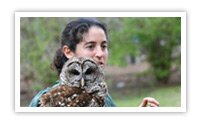


Wildlife viewing opportunities abound in western Kentucky. Our area includes the migration route of warblers, waterfowl and bald eagles. Other wildlife in western Kentucky include: Elk, Bison, White tailed deer, Wild Turkey, Raccoon, Coyote, Squirrel and Rabbit. Species of birds found in the area include: Bald Eagles, Osprey, Blue Heron, Canadian Geese and Hawks.
WILDLIFE VIEWING IN PUBLIC WILDLIFE MANAGEMENT AREAS
Since wild creatures are more active at dawn and dusk, these are the best times to watch wildlife. The widest variety of species can be seen during spring and fall migrations. Although few of these public areas have developed recreational facilities, wildlife management areas are excellent places to go hiking, birding or simply enjoy the outdoors and get back in touch with nature. Native wildlife in these areas: Coyote, deer, dove, furbearers, quail, rabbit, songbirds, squirrel, Raccoons, turkey and waterfowl. Click here for a list of the Public Wildlife Management Areas in western Kentucky.
WILDLIFE VIEWING IN LAND BETWEEN THE LAKES
 LBL offers wildlife viewing year-round, but different species may be more viewable at certain times of the year. Typically, early morning or late evening are the best times of day, as most mammals and birds are active at those times. Some of the best places to see wildlife include the Environmental Education Area near The Nature Station, the Elk & Bison Prairie near Golden Pond, the South Bison Range and the Bear Creek area.
LBL offers wildlife viewing year-round, but different species may be more viewable at certain times of the year. Typically, early morning or late evening are the best times of day, as most mammals and birds are active at those times. Some of the best places to see wildlife include the Environmental Education Area near The Nature Station, the Elk & Bison Prairie near Golden Pond, the South Bison Range and the Bear Creek area.
LBL is home to two species of deer -- white-tailed and Fallow -- as well as American bison and elk. The fallow deer herd is a unique aspect of our wildlife inhabitants. This species, native to Europe and Asia, was brought to LBL by the Hillman Land Company in 1918. LBL's herd is believed to be the oldest population of fallow deer in the country, and at one time was the largest. Today the herd numbers fewer than 150 and hunting of fallow deer is not permitted. Although LBL's wildlife management activities focus on native species, the fallow herd is maintained for wildlife viewing and because of its historical significance.
LBL's bird population is equally diverse. LBL hosts a variety of migratory birds, from wintering bald eagles, gulls, ducks and geese, to neotropical migratory birds such as hummingbirds, warblers and tanagers. Numerous wading birds such as the great blue heron and birds of prey such as eagles, osprey, owl and hawk also live here.

BALD EAGLES - In 1999, 14 bald eagle nests were counted at LBL. LBL is also home to a large winter population of eagles. These birds, often 100-150 of them, will migrate to LBL from southern Canada and Michigan, spending the December through March months in our comparatively warmer climate. In January and February, LBL and the state parks offer guided eagle watching tours.
ELK, BISON - Elk have their most impressive antlers from September-December. Elk were first reintroduced to LBL in 1995; by 1999, the herd was estimated at more than 53. LBL's herd and four bulls were released in the 750-acre Elk & Bison Prairie, located near the Golden Pond Visitor Center. Just over 100 bison are maintained in LBL.
OSPREY - Summertime visitors today are often treated to the site of osprey plunging "feet-first" into the waters of Kentucky Lake and Lake Barkley after their primary prey, fish. As you traverse Lake Barkley, the large nests on platforms that you see belong to Osprey. Watch their young grow up. The platforms were built to assist in the return of osprey to western Kentucky.
CANADIAN GEESE can be seen at LBL's Honker and Hematite Lakes near the Nature Station, Energy Lake and along many bays. Catfish Kitchen Restaurant on US 641 N has 2 large catfish ponds that are home to about 50 geese year-round and even more after spring hatching.
LBL’S WOODLAND NATURE STATION
 Experience an up-close encounter with the plants and animals of the region. You can stand just a wingspan from the Great Horned OWL, see the rare and elusive Red Wolf or howl with a Coyote. Look up and see our Bobcat eyeing you from a high tree branch. Look for majestic palmated antlers and you will spot our European Fallow Deer. You'll learn what our Backyard animals eat, what special adaptations they have evolved and how the different species communicate. Most of our Backyard animals are here because they could not survive in the wild -- they have either been injured, orphaned or have lost their natural fear of humans. The exception is the Red Wolf, part of a breeding program attempting to restore this extremely endangered species. Visit the Nature Station
Experience an up-close encounter with the plants and animals of the region. You can stand just a wingspan from the Great Horned OWL, see the rare and elusive Red Wolf or howl with a Coyote. Look up and see our Bobcat eyeing you from a high tree branch. Look for majestic palmated antlers and you will spot our European Fallow Deer. You'll learn what our Backyard animals eat, what special adaptations they have evolved and how the different species communicate. Most of our Backyard animals are here because they could not survive in the wild -- they have either been injured, orphaned or have lost their natural fear of humans. The exception is the Red Wolf, part of a breeding program attempting to restore this extremely endangered species. Visit the Nature Station
Area & State visitor's guides & brochures!


See what western Ky has to offer!

Search who, what, when & where!
